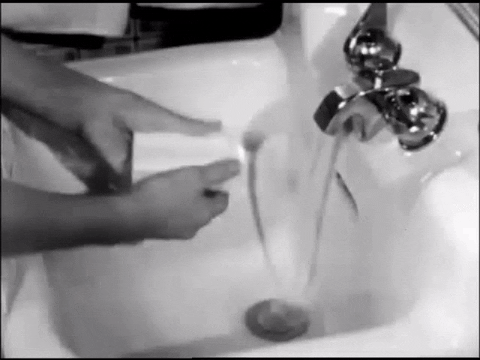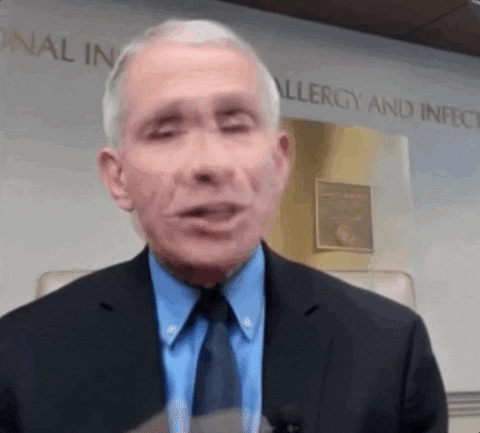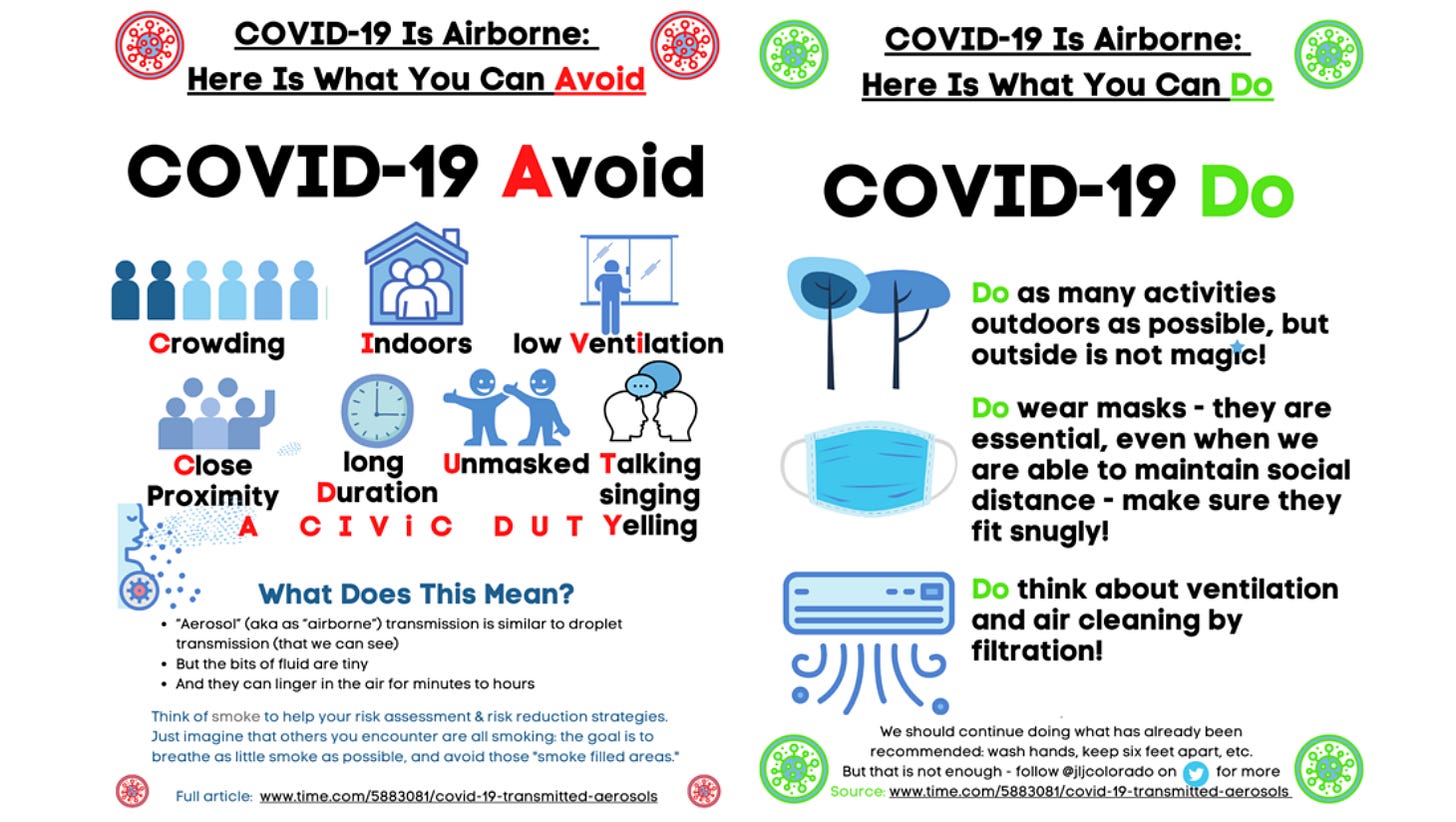Every decision is so daunting. No answer feels right. We are struggling together in this unrelenting headwind, looking at the horizon through tense slits.
Our next hill? The Holidays.
We’ll talk more next week about conversations and game plans to navigate the holiday season. But before I share my specific thoughts on Grandma’s turkey dinner, I want take some time to review what we currently know about COVID-19 spread.
We’ve got to do our best to understand how the SARS-CoV-2 virus is infecting us; effective preparation requires this knowledge. Then, we will become more confident and comfortable in our decision-making while we press forward.
What do we know about how SARS-CoV-2 is spread?
The SARS-CoV-2 virus is spread in two ways. First, by the things we touch. This is called fomite transmission. It happens when we touch a surface covered with infectious virus, get the virus on our hands, and bring it to our face. This type of spread is what made us all Lysol our mail, wait two days to touch our Amazon boxes (No way to live!), and wash our groceries. But, that was early in the Pandemic.
We now know this form of transmission is not as significant as we once thought. SARS-CoV-2 does not jump off the counter and infect you as you reach for the cereal box. You have to physically move the virus from a surface to your face. This is a clumsy and inefficient way to spread infection; easily thwarted by common hygiene practices.
We have the power to stop this chain of spread by washing our hands with soap and water as often as we can. Hand sanitizer is a great backup player. And just in case we don’t wash enough, we can wipe down commonly touched surfaces to decrease the likelihood the nasty virus will get on our hands to begin with.
Pretty straightforward.

The second and more important way the virus is transmitted is where it gets more complicated.
So, what’s that?
After six months of Pandemic life, it has become clear that infection spreads through the air we share. The challenge is that experts disagree about how the virus infects humans through the air, specifically if the virus spreads through droplets and/or aerosols. Although this may seem like scientific semantics, the distinction is significant when we are trying to prevent death by disease.
Essentially the debate boils down to how, ahem, size matters.
First, let’s talk droplets. I like to think of droplets as the spittle we create when we talk, scream, cough and sneeze. “Spittle” is such a great word, isn’t it? Droplets are relatively heavy things, large enough to have inertia, so they have the ability to land on another person in close proximity when ejected.
When Grandpa laughs and the spittle flies, the droplets he creates during the laugh shoot out of his mouth, succumb to gravity’s pull, and fall to the ground within a 6 foot radius. The more talking, yelling, and screaming he does; the more droplets are created and more particles are spit and spread. It is this droplet theory where our operational definition of 6 feet social distancing originates.

The concern, of course, is that if Grandpa is within an infectious period of the COVID-19 illness, these small particles of moisture will physically contain live virus. If enough of these droplets get into the mouth, nose, or eyes of someone standing close by; the virus could take hold and begin to replicate its newest, unsuspecting victim.
Masks help limit the spread of droplets. Well-fitting masks physically catch the spittle so the radius of the spray is dramatically reduced. Not eliminate, but reduce. In addition, masks also help protect the wearer by limiting the amount of sprayed virus the mask-wearer might receive. Masks are lowering infection rates in places where they are mandated. They are working to prevent illness and death. Keep wearing your masks. But since all droplets are not eliminated by wearing a mask, keeping physical distance from others is another layer of protection. This is starting to make sense, right?
Washing hands. Cleaning surfaces. Wear a mask. Keep your distance.
You said there was a debate?
Right, right. Here it is. Scientists believe there is another way that SARS-CoV-2 is spread through the air. Aerosols. When we talk, yell, cough and sneeze; we create droplets and aerosols. Aerosols behave very differently than droplets once released into the air. This distinction may be pivotal to infection control and public health.
Aerosols are super-tiny, invisible droplets. To understand aerosols, bring yourself back to the 1990s when your roommate would spray her high bangs with Rave hairspray. Remember how the hairspray made a sticky, rough film over everything in the bathroom? You could feel Rave residue all over the counter, bathtub, toilet, even the door across the hall. That’s aerosol spray. Clean it up, Becky.

Aerosol particles are so tiny, they linger and drift, spanning distances well beyond six feet. The particles get swirled around by air currents, gracefully floating around plexiglass barriers and face shields until they are gently inhaled or disintegrate. In addition, aerosols can accumulate over time in small areas, like when all three of your roommates were getting ready to go out on Friday night. The Rave cloud got bigger and bigger and the bathroom air foggier, until it would spill out into the hallway and make you cough as you walked by.
Scientists are increasingly concerned about aerosolized SARS-CoV-2 being the primary infectious mechanism because droplet spread cannot explain “superspreader events” or why outside is better than inside. Plus, so many people with COVID-19 don’t know how they got infected. It’s not like you forget or don’t notice if you are directly sneezed on, or someone is yelling at you from a close distance.
There must be properties of the virus that help it along.
When infectious particles waft around in dense clouds, that’s when scientists get nervous. Infectious aerosols are easily inhaled. The more particles that exist in the inhaled air? The more likely a person is to get infected.
Srsly? Who cares?
This matters because the peak of a person’s infectious-ness (Is that a word?) is just before and right at the beginning of symptoms. Read that again. Just before to right at the beginning. That means Grandpa can spray his infected spittle and your roommate can yell her infectious cloud before either of them know they are sick. This is one of the reasons SARS-CoV-2 is so tricky.

Okay, fine. Let’s say you can get the virus through aerosols. How can I protect my family?
That’s the first “V” of the season! Ventilation!
Ventilation is an increasingly important instrument in our symphony of protection, so we need to understand the why, what, and how.
Why does ventilation help?
If getting infected depends on the amount of viral particles we see over a period of time, then ventilation helps by diluting particles over time and space. If you create an environment of air that is constantly changing, the plumes of aerosolized virus are dissipated through air currents and exchanged with clean air. Fewer viral particles in the air? The less likely we will get sick.
If we limit the air we share, we limit our risk.
What can I do to improve ventilation?
Ventilation is an exchange of dirty air with clean air through two main methods, air exchange and air filtration. We can either exchange indoor air with outdoor air, or clean the indoor air that cannot escape.
Want to see this in action? This is a great visual of how ventilation is protective.
And, how?
Thou shall wear your mask. Masks decrease the transmission of both droplets AND aerosols. Layered cotton masks are less effective against smaller particles, but have been shown to reduce a percentage of both inhaled and exhaled aerosols. If you are outside of your home and around other humans, you should be wearing a mask.

Open your windows! Open at least two windows to generate a cross-breeze. Remember, ventilation is mixing outdoor air with indoor air. The more open windows, the better. As an added measure, you could turn on the exhaust fans in your home (bathrooms) because these push air straight outside.
Add a fan. If you only have one window available to open, add a fan to push indoor air out. Keep in mind, running a fan in a close space (no open windows) will just push the infected indoor air father around the room, defeating the purpose. If a window is not open, do not turn on a fan.
No windows? Use an air cleaner. Air cleaners exchange the room air though filters (MERV14 or higher) and Brownian Motion helps filters to capture the small aerosols. Hello, physics! Interested in purchasing an air cleaner? Here’s a review of the most popular and cost-efficient purifiers from the NYT. In addition, here’s the nerdiest Twitter thread about portable air cleaners.

Use your HVAC. High-efficiency media filters (MERV14 or higher) will clean the air through your HVAC system. Turn on the fan on your thermostat after installing a high-efficiency filter. Use HVAC UV units, if you’ve got ‘em.
Don’t have that kind of cash? DIY. Learn how to make your own “homebrew” air purifier in this piece from Wired.
Finally, consider indoor humidification. SARS-CoV-2 survives longer in dryer air. In addition, dry, cool air hinders the effectiveness of our natural mucosal infection barriers, decreases our protective mucous production, and lowers our ciliary clearance function. (Isn’t the body fun?) Humidification matters more in a shared room more than closer proximity. And although humidification is not currently a standard recommendation for disease prevention, humidification of 40-60% is a reasonable goal.
Here’s your summary slide. Decrease your family’s risk of illness by taking what you know about how the virus makes you sick, what higher-risk environments look like, and why your decisions matter. This is the only way we will be able to continue living our lives, going to school, and seeing our loved ones. Let’s gets over the next hill. Together.

The other important “V” of the season? It’s your VOTE.
I’ll close with a quick word about voting. I want every single one of you to exercise your constitutional right to vote. I’ve talked with all my 18-year-old patients about their voting plan. I’ve admired their dedication to the democratic process and their excitement in the act that will shape our future.
If you have not already cast your ballot, know there are ways to vote safely. For those of you in Kansas or Missouri, this information may be helpful to you. In addition, visit this piece from COVID Explained for additional insight. (I suggest you also subscribe. It’s a great reference.)

What’s next:
My thoughts on the melodrama of the holidays, including some risk mitigation tools that you will find helpful. Then, we’ll turn to CBD and kids, and a probiotic primer. Plus, this Friday is the first edition of my Three-Two-One. What’s that? Subscribe and find out!
Thanks for reading all the way down to the bottom. If this was helpful to you, I’d appreciate sharing this with someone you know. Stay well.



